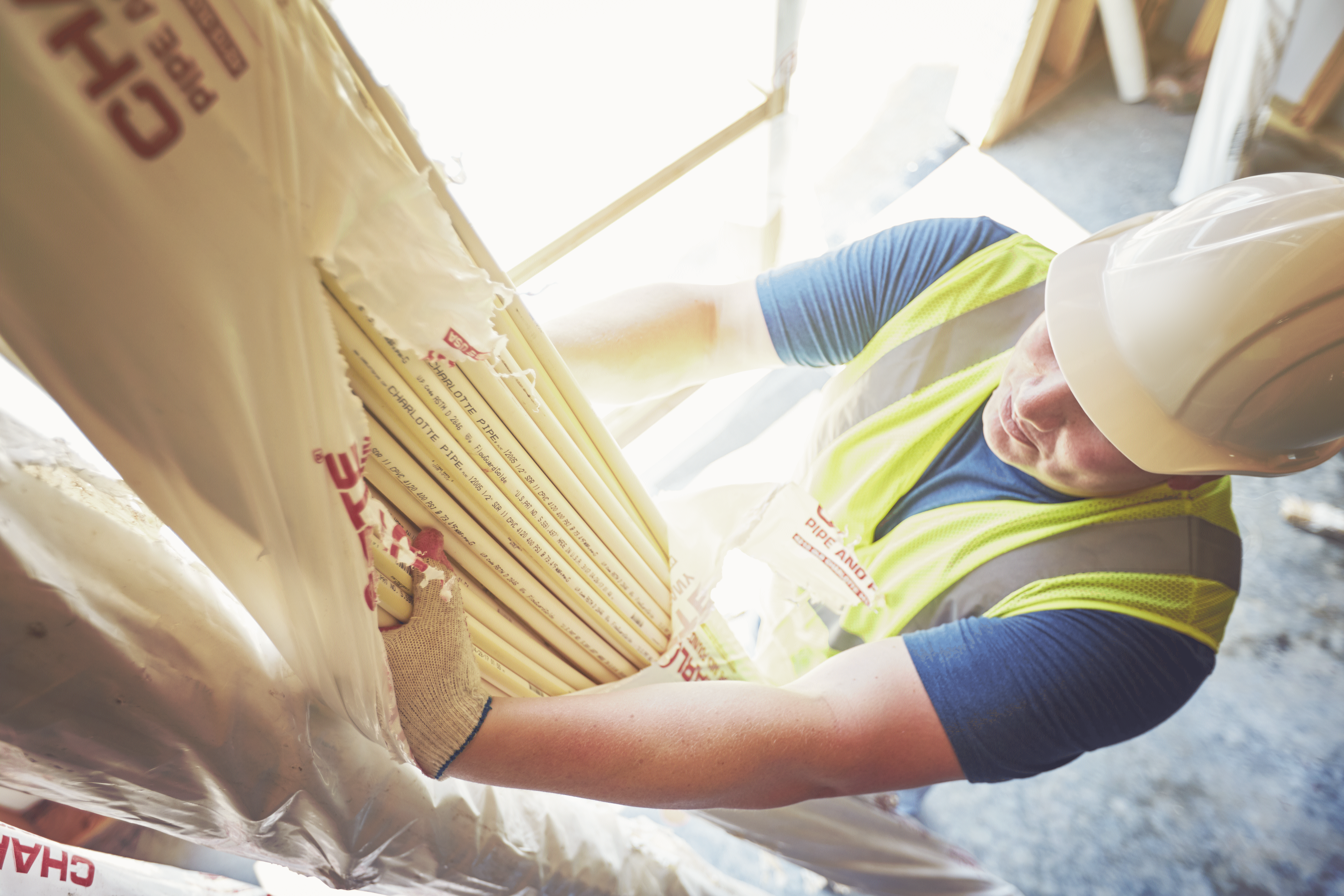
By: Jonathan Simon on May 13th, 2020
Frequently Asked Questions on the Performance of CPVC in Residential Plumbing
Installation | PEX | CPVC
At FlowGuard Gold® CPVC we strive to provide complete and accurate information to plumbers and homeowners regarding use of CPVC in residential plumbing. To that end, we’ve compiled the answers to frequently asked questions in this post.
What is the expected lifespan of CPVC in residential plumbing?
CPVC was first introduced in the U.S. in 1959 and some of the earliest installations are still in service today so CPVC has proven exceptionally reliable in residential plumbing. FlowGuard Gold pipe and fittings are designed for a 50-year service life with a safety factor of 2.
How does CPVC reliability compare to other materials?
CPVC stands for chlorinated polyvinyl chloride; this is important because the fact that CPVC is chlorinated gives it an advantage in dealing with common water treatment chemicals compared to other materials. The chlorine molecules in the pipe effectively block the chlorine and chloramine in the water supply from attacking the pipe, making the material immune to chlorine degradation and extending the lifespan. CPVC is also virtually impermeable and is not subject to unsafe leaching.
Neither PEX nor copper, the other materials commonly used for residential plumbing today, have a similar chlorine barrier and both are subject to chlorine degradation that can shorten expected lifespans. PEX is also susceptible to permeation and leaching, which can introduce unwanted chemicals into the water supply.
FlowGuard Gold CPVC complies with ASTM standards and is designed for reliable operation at higher pressures than other plumbing systems. It can operate constantly at 100 psi at 180° F or 400 psi at 73° F.
Is all CPVC the same?
While all CPVC pipes and fittings share a common chemical composition, there are important differences between generic CPVC and FlowGuard Gold CPVC. All FlowGuard Gold pipes and fittings sold in the United States are made from resins and compounds produced at Lubrizol’s Louisville, Kentucky facility to ensure consistent quality. FlowGuard Gold pipe and fittings have the only complete plumbing system that is pressure rated by the Plastic Pipe Institute and consistently outperforms generic CPVC. For example, FlowGuard Gold CPVC provides as much as 92% higher sustained pressure resistance at elevated temperatures compared to generic CPVC.
What is the most common cause of failure in CPVC?
While FlowGuard Gold CPVC is designed for a 50-year service life with a safety factor of 2, the systems can fail earlier if they are not properly installed or handled. Spontaneous failures are extremely rare and when they do happen, they can typically be traced back to exposure to a critical installation error.
What are the causes of CPVC failure related to improper installation?
FlowGuard Gold CPVC installation procedures are straightforward and easy-to-follow. Failing to follow recommended procedures can compromise the integrity of any plumbing system. While failures are rare, when we do receive and analyze a failure, there are a few installation errors that show up most frequently:
- Chemical incompatibility: No matter what materials you use, ensuring chemical compatibility is essential to proper installation. To aid in that effort, we have established a structured system compatibility program, in which we work with manufacturers of ancillary products to ensure they have no compatibility issues with FlowGuard Gold pipes and fittings. It’s the only program of its type in the industry and working with materials certified as compatible eliminates compatibility issues.
- Expansion and contraction. Thermal expansion and contraction can create stress on fittings if not properly accounted for. FlowGuard Gold CPVC provides an online expansion calculator to make it easy to account for expansion and contraction in system design.
- Improper solvent cement application: CPVC uses a solvent welding process to join pipes and fittings, creating joints that are actually stronger than the pipe itself. Applying too much solvent cement can cause the cement to pool in the pipe or fitting, diminishing the pressure-bearing capability of the material. Applying too little prevents a solvent weld from forming. FlowGuard Gold CPVC installation instructions recommend applying a heavy, even coat of solvent cement to the outside of the pipe end and then using the same applicator without additional cement to apply a thin coat inside the socket.
Always be sure you are familiar with manufacturer recommended installation processes before installing any piping material.
Will CPVC fail because it gets brittle?
When properly installed and handled, CPVC will not spontaneously fail due to brittleness. As CPVC ages, it becomes more rigid giving it increased pressure-bearing capability, but this increased rigidity comes with reduced ductility, sometimes referred to as “brittleness”. If the system was improperly installed under excessive stress, over time failures may occur.
However, the most common problem we see in the field related to “brittleness” is the result of improper tool use on the part of service contractors.
What tools should be used to install or service CPVC?
When cutting into aged CPVC pipe on a service call, it is critical that a non-compressive tool be used, this includes a c-style tubing cutter, wheel cutter or a fine-tooth saw. If ratchet cutters or shears are used in service, the pipe may be damaged.
New CPVC pipe can be cut using a standard ratchet cutter, C-style tubing cutter or wheel cutter. Non-ratcheting pipe shears or PEX cutters should never be used. A chamfering tool is recommended to bevel the edge of the pipe before inserting the pipe into the fitting. We also offer a one-step solvent cement for creating strong welds between pipes and fittings.
Can CPVC be installed underground or in slabs?
CPVC can be installed under slab, underground or encased in concrete. This does not affect the performance of the CPVC. When installed in the ground, care should be taken to ensure the ground is not contaminated with incompatible chemicals.
How can I join a CPVC plumbing system?
FlowGuard Gold CPVC can be joined using FlowGuard Gold one-step solvent cement. For service applications where a faster cure time is needed, we recommend Oatey® Orange Lava CPVC Cut-In solvent cement. It enables rapid, one-step cure times as fast as 15 minutes for cold water lines.
Two-step solvent welding (primer + regular orange CPVC solvent cement) is permitted on FlowGuard Gold CPVC, however cure times may be longer than when using one-step cement.
Push-connect fittings that have been tested to ASSE 1061 and are listed for use with CPVC can be used on FlowGuard Gold CPVC for emergency repairs where immediate return to operation is needed, however a solvent welded connection is still the preferred method of joining pipe and fittings.
What is the difference between PVC and CPVC?
PVC pipe is not the same as CPVC pipe. PVC is incapable of handling the temperatures and pressures that can be experienced in a domestic water distribution system and is not permitted by code to be used for water distribution inside a home. CPVC is code-approved for residential plumbing and can be used for the complete residential plumbing system.
Where can I learn more about CPVC?
Our web site, FlowGuardGold.com has a wealth of materials related to CPVC installation and performance. Here are a few suggestions to get you started:
- Types of Plastic Piping: Choosing the Right Material
- FlowGuard Gold CPVC Installation Training Webinar
- FlowGuard Gold CPVC Resources for Service Plumbers
Do you have a question we didn’t answer? Contact us for more information.


